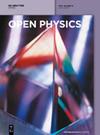利用三次 B-样条函数数值求解广义 Atangana-Baleanu 时分数 FitzHugh-Nagumo 方程
IF 1.8
4区 物理与天体物理
Q2 PHYSICS, MULTIDISCIPLINARY
引用次数: 0
摘要
经典 FitzHugh-Nagumo 模型的广义化结合了非线性和分数导数,从而更准确地描述了神经元的物理现象。在本文中,我们提出了一种利用 B-样条函数求解 Atangana-Baleanu 分数导数意义上的时间分数 FitzHugh-Nagumo 方程 (TFFNE) 的数值方法。所提出的方法采用有限差分方案对分数导数进行时间离散化,而采用 θ θ 加权方案对空间方向进行离散化。数值结果和收敛速率证明了该方案的效率。研究了在不同的非整数参数值、时间方向和空间方向上的收敛阶次和误差规范。最后,通过对三个应用的分析,检验了所提方法的有效性。本文章由计算机程序翻译,如有差异,请以英文原文为准。
Numerical solutions of generalized Atangana–Baleanu time-fractional FitzHugh–Nagumo equation using cubic B-spline functions
The generalization of the classical FitzHugh–Nagumo model provides a more accurate description of the physical phenomena of neurons by incorporating both nonlinearity and fractional derivatives. In this article, we present a numerical method for solving the time-fractional FitzHugh–Nagumo equation (TFFNE) in the sense of the Atangana–Baleanu fractional derivative using B-spline functions. The proposed method employs a finite difference scheme to discretize the fractional derivative in time, while θ \theta -weighted scheme is used to discretize the space directions. The efficiency of the scheme is demonstrated through numerical results and rate of convergence. The convergence order and error norms are studied at different values of the noninteger parameter, temporal directions, and spatial directions. Finally, the effectiveness of the proposed methodology is examined through the analysis of three applications.
求助全文
通过发布文献求助,成功后即可免费获取论文全文。
去求助
来源期刊

Open Physics
PHYSICS, MULTIDISCIPLINARY-
CiteScore
3.20
自引率
5.30%
发文量
82
审稿时长
18 weeks
期刊介绍:
Open Physics is a peer-reviewed, open access, electronic journal devoted to the publication of fundamental research results in all fields of physics. The journal provides the readers with free, instant, and permanent access to all content worldwide; and the authors with extensive promotion of published articles, long-time preservation, language-correction services, no space constraints and immediate publication. Our standard policy requires each paper to be reviewed by at least two Referees and the peer-review process is single-blind.
 求助内容:
求助内容: 应助结果提醒方式:
应助结果提醒方式:


